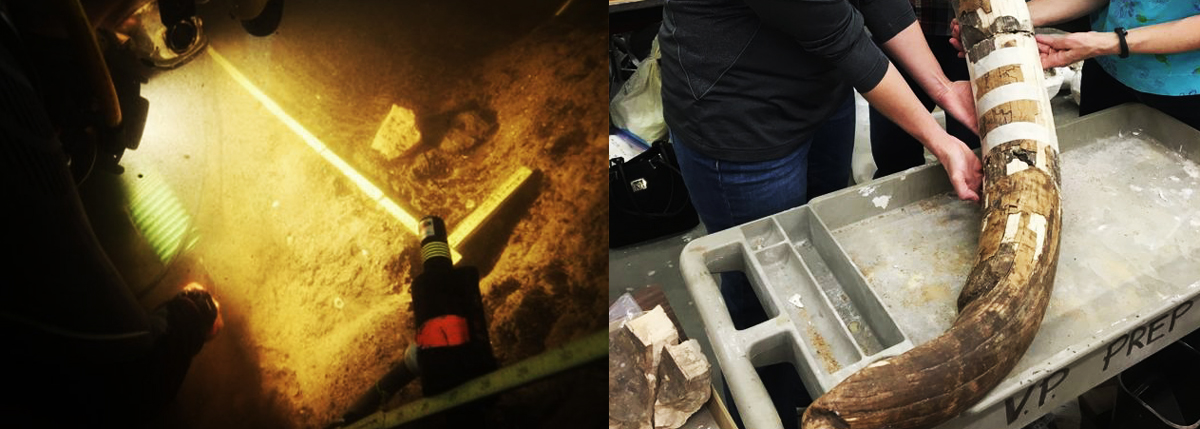


An article on BBC News by Science reporter Jonathan Webb - Mastodon meal scraps revise US prehistory - reports on the stone tools and bones from a butchered mastodon, found at the bottom of a river in Florida, which are shaking up the known history of humans in the region.

The mastodon tusk discovery. Image: S. Joy/CSFA. Reconstructed for the study. Image: DC Fisher/U. MICHIGAN MUSEUM OF PALEONTOLOGY
A four-year investigation of the site has proved that humans lived there and, in particular, butchered a mastodon 14,550 years ago. This is more than a millennium earlier than humans were thought to have settled the south-eastern US. The findings are reported in the open access journal Science Advances.
Mastodon meal scraps revise US #prehistoryhttps://t.co/d4oXuTxAGl pic.twitter.com/IlL9h9khH2
— Bradshaw Foundation (@BradshawFND) May 16, 2016
Image: Brendan Fenerty
The research reinforces the idea that humans settled the Americas well before the Clovis people arrived about 13,000 years ago. For many years, the Clovis were thought to have been 'the first Americans'.
In fact, the mastodon tusk that is the centrepiece of the Florida haul, complete with apparent cut marks and accompanying tools, was first found and dated in the 1980s - but recent analysis has provided new evidence.
"(It) was an impossible date for the scientific community to accept at the time, because it was well accepted that the Americas were colonised by the Clovis people, who arrived on the continent over the Bering land bridge no longer than 13,500 years ago at the oldest," said Jessi Halligan, lead author of the new study and assistant professor of anthropology at Florida State University.
That view, however, has gradually been revised as more and more evidence accumulates that humans arrived thousands of years earlier - perhaps as early as 16,000 years ago, when the last ice age was only beginning to thaw.
The researchers re-examined the original mastodon tusk in detail, as well as collecting a wealth of further evidence from the Aucilla River site. The additional material included many more tools, animal bones, and dung samples whose chewed-up vegetable matter allowed for conclusive, accurate carbon dating.
Before the river and sediments were laid down, this area appears to have contained a water hole where both animals and humans gathered. The mastadon was either hunted or scavenged, and butchered using tools like the small stone knives - bifaces - which were found at the site.
One of the co-authors, Prof Michael Waters from Texas A&M University, states that the stone tools and faunal remains at the site show that at 14,550 years ago, people knew how to find game, fresh water and material for making tools.
Visit the American Rock Art Archive:
by Bradshaw Foundation
Monday 04 December 2023
by Bradshaw Foundation
Friday 30 June 2023
by Bradshaw Foundation
Thursday 06 April 2023
by Bradshaw Foundation
Thursday 24 November 2022
by Bradshaw Foundation
Tuesday 27 September 2022
by Bradshaw Foundation
Thursday 08 September 2022
by Bradshaw Foundation
Tuesday 19 July 2022
by Bradshaw Foundation
Monday 06 June 2022
by Bradshaw Foundation
Friday 11 March 2022
by Bradshaw Foundation
Wednesday 02 March 2022
by Bradshaw Foundation
Thursday 26 August 2021
by Bradshaw Foundation
Monday 16 August 2021
by Bradshaw Foundation
Tuesday 06 July 2021
by Bradshaw Foundation
Thursday 06 May 2021
by Bradshaw Foundation
Thursday 06 May 2021
by Bradshaw Foundation
Tuesday 16 March 2021
by Bradshaw Foundation
Monday 04 December 2023
by Bradshaw Foundation
Friday 30 June 2023
by Bradshaw Foundation
Thursday 06 April 2023
by Bradshaw Foundation
Thursday 24 November 2022
by Bradshaw Foundation
Tuesday 27 September 2022
by Bradshaw Foundation
Thursday 08 September 2022
by Bradshaw Foundation
Tuesday 19 July 2022
by Bradshaw Foundation
Monday 06 June 2022
by Bradshaw Foundation
Friday 11 March 2022
by Bradshaw Foundation
Wednesday 02 March 2022
by Bradshaw Foundation
Thursday 26 August 2021
by Bradshaw Foundation
Monday 16 August 2021
by Bradshaw Foundation
Tuesday 06 July 2021
by Bradshaw Foundation
Thursday 06 May 2021
by Bradshaw Foundation
Thursday 06 May 2021
by Bradshaw Foundation
Tuesday 16 March 2021
Friend of the Foundation











